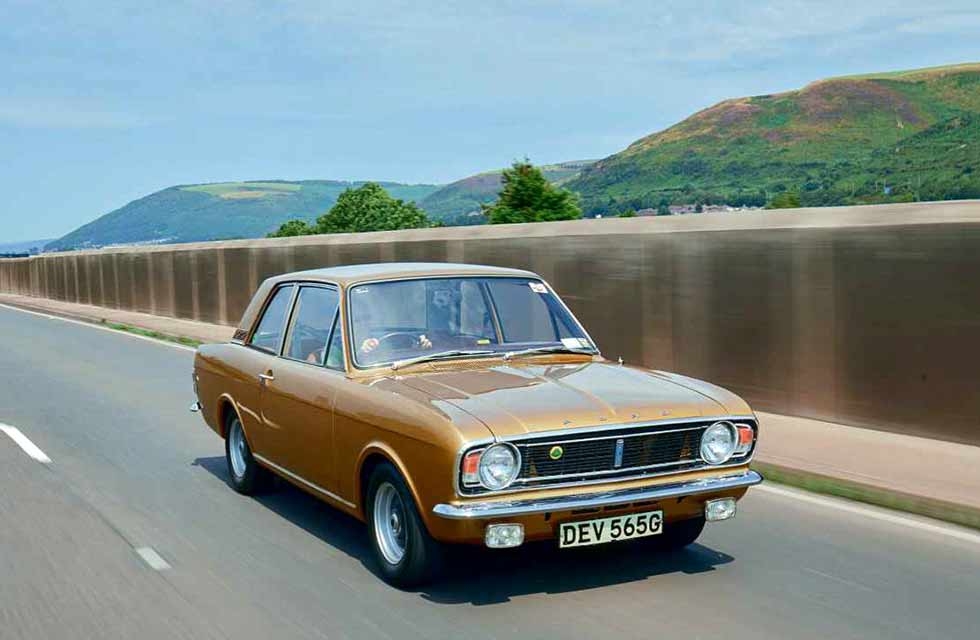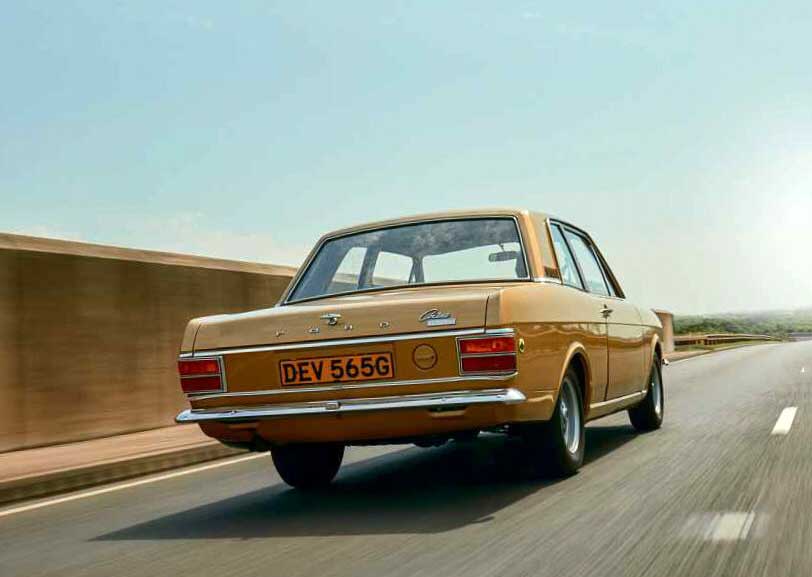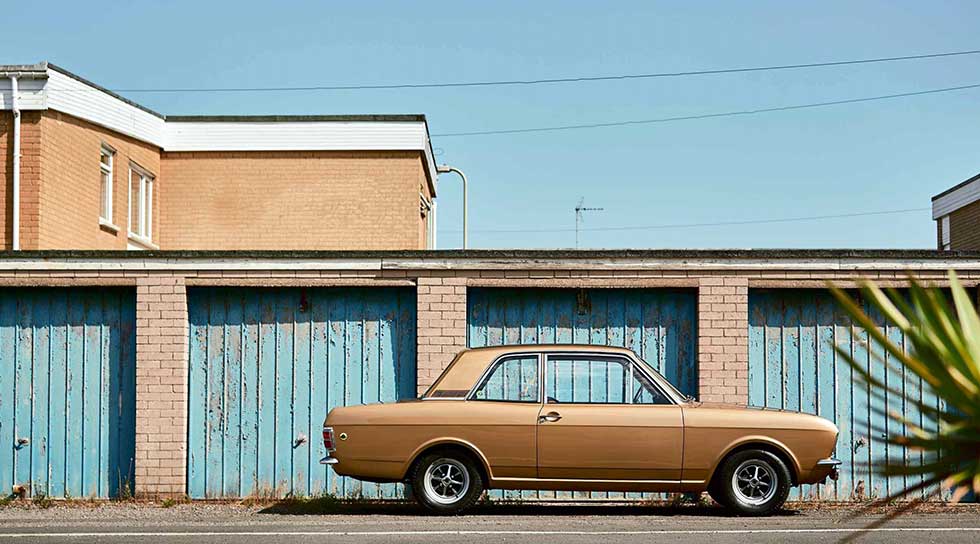
This Ford Cortina may not look particularly special – but it’s a Cortina Lotus, and it was Colin Chapman’s personal transport. Mark Dixon took it for a late-60s spin. Photography Matthew Howell.
Colin Chapman’s Cortina
Driving the Lotus legend’s Mk2 Chapman’s Cortina. The sports saloon run by Mr Lotus himself.
You have to look pretty closely to spot the ding in the bright-metal trim above the offside headlight. It’s a rare blemish on a car that otherwise appears near-concours in condition. But that ding has a story behind it: reputedly, Lotus boss Colin Chapman made it when driving too fast into one of the factory’s garages.

For this is not just any Cortina; it’s not even ‘just another’ Cortina Lotus. This immaculate ’60s executive saloon was Chapman’s personal car, given to him by Ford in 1969, and one in which he racked-up some 14,000 miles. Rather fast miles, it seems: the story goes that the gatehouse guard at Lotus’s new Hethel factory would have to rush to lift the barrier whenever he saw Chapman’s Cortina approaching; if he was too slow, Chapman would simply knock the barrier off its mount by driving into it.
Exactly why Ford donated the car isn’t clear. Maybe it was a gesture of goodwill, having taken control of the Mk2 Cortina Lotus away from Hethel by setting up the production line at Dagenham. Maybe they simply thought they could afford to, since the Cortina Lotus (by then badged Cortina Twin Cam, as on this car) was soon to go out of production, once the Escort Twin Cam had come on stream to take over frontline motorsport duties. Colin’s son Clive, who today runs Classic Team Lotus and was a child during the 1970s, has no recollection of the car at all, unfortunately.
The Mk2 never had quite the competition impact of its storied predecessor, whose three-wheeling antics in the hands of Jim Clark were the stuff of legend. But then, it didn’t need to. The Escort Twin Cam appeared within a year of the Mk2’s launch and was better-suited to the race and rally types, being lighter and more compact, and Ford’s intention was always to make the Cortina Lotus more refined, more comfortable and more livable-with on a daily basis than the model that went before.

Not that the Cortina Lotus was all mouth and no trousers. Based on the two-door Cortina GT, the Lotus version used the stronger export-version bodyshell and had its suspension extensively tweaked and revised, including a one-inch reduction in ride height and a wider track thanks to 5½J steel wheels. And if you were really serious about speccingup your ‘Lotus’, there was a credible list of optional competition parts, ranging from alloy doors, bonnet and bootlid through to sump and fuel tank guards, and even fuel injection. Assembling the Mk2 at Dagenham meant that Ford could also keep tabs on build quality.
Driving this low-mileage example – the recorded figure is still barely 25,000 – shows how well they succeeded in making a userfriendly road car. You notice the attention to detail before you even turn the key, finding the static seatbelts neatly clipped onto keeper tongues mounted on the transmission tunnel.
It’s undeniably brown in here, the Saddle Tan seats and doorcards complemented by a darker moulded dashboard and exposed metal doortops painted in the Amber Gold body colour, but it looks coherently styled, with clear, easy-to- read gauges and a simple slider-control heater system. Above all, it feels modern.
Turn the key and pull away, and that sense of modernity continues. The steering wheel may be an alloy-spoked, deep-dished sporty little number redolent of driving gloves and flat caps, but the steering itself is pleasantly light, so much so you could almost imagine it to be power-assisted. Combined with the Cortina’s boxy contours and ultra-slim window pillars – oh, how we miss those slim pillars in modern cars! – it makes the car very easy to position on the road and thread through traffic. This midsized executive saloon is 5½ inches (we hadn’t gone metric in 1969) narrower than a modern Mini; in fact, if you count the Mini’s chunky door-mirrors, it’s well over a foot narrower.
‘LEAN HARDER ON THE THROTTLE AND THE TWIN-CAM’S REFINED EXHAUST NOTE GAINS A BIT OF BITE’
Like the steering, the gearchange is also fingertip-light, despite the stubby lever having a relatively short throw. The gate is very close – and there’s no detent between first and reverse – so a certain amount of concentration is needed to avoid wrong-slotting, but it’s another tick on the list of positive attributes. The ’Tina still feels quick, too; not remotely fast by modern standards, but brisk enough to be fun. The twin-Webered engine is a bit fluffy at lower revs – put that down to a lack of use, and the need for a general tune-up – but once it gets above 3000rpm, it clears its throat and feels nicely punchy, pulling strongly from there on upwards and feeling unstressed at a 70mph motorway cruise, even though only four rather than five forward gears mean the engine is now spinning at 3800rpm. Incidentally, a handy GPS-based mobile phone app proved that the speedometer is dead-on accurate; modern technology does have its uses.
On a hot day, motoring through a gritty ’60s suburb in the South Wales coastal town of Porthcawl and alongside the concrete-flanked dual-carriageway that skirts the steelworks of Port Talbot, driving the Cortina feels like Get Carter with added sunshine. Aeroflow golf-ball vents notwithstanding, you need the window down for ventilation as much as for posing; there’s no air-con, of course, a fact that’s worth mentioning only because the Cortina otherwise gives so little away to a ‘modern’ for driver comfort. Apart from those vinyl seats, which were the bane of children’s bare legs in the summers of the 1960s and ’70s.
While you’re pootling along, the twin-cam engine sounds unexpectedly discreet, but lean harder on the throttle and its refined exhaust note gains a bit of bite overlaid with a trace of induction noise – those 40DCOEs were never going to keep totally quiet, despite the efforts of a back-box-sized air filter that apparently took Ford months to develop.

The substantial presence of the Webers and the extra width of the twin-cam head meant that, as with the Ford Cortina Lotus Mk1, the battery had to be relocated to the boot. Moving it didn’t harm the car’s weight distribution, and the Cortina has a deliciously pointy, neutral feel to its handling. The racing Mk1’s short-lived dalliance with an A-frame rear suspension, instead of the traditional leaf springs that it started with, reverted to, and then passed on to the Mk2, proved that a good leaf-sprung set-up can work remarkably well. With its road-car bias, it’s no surprise that there’s a fair degree of body roll during committed cornering, but it’s not excessive and the car remains tidy; oversteer would not be difficult to achieve – or succumb to – on a wet road.
If there’s a question-mark to place alongside all these ticks in the mental check-list, it’s that the ride is a little jiggly; but that could well be because the car’s never had a complete overhaul; a slight wheel shimmy and a creaking ball-joint are further evidence that the suspension could do with a freshen-up. No matter: the essential quality of the design still shines through. Any young blade who was lucky enough to afford a Cortina Lotus back in the day would have thought himself the bee’s knees, and rightly so.
The ever-practical founder of Lotus certainly wasn’t going to look a gift-horse in the mouth, and he used this car until well into the 1970s, even though it was just one of a personal stable that included an Elan +2, a Ford Galaxie 500 and a Range Rover. One quirk is the fitment of a Cortina Estate tailgate handle on the bootlid; it seems the ever-in-a-hurry Chapman couldn’t be doing with having to fiddle around with a key to raise the lid. Another is the upside-down Lotus badge on the offside rear flank – the reason for this is unknown – while the period Texaco sticker on the windscreen, which depicts a Lotus 72 in JPS colours, may be another legacy of Chapman’s tenure.
When he finally stopped driving the Cortina, still with only 14,233 miles on the clock, it passed to the factory’s museum, until that was closed and its contents sold at a Coys auction in 1998 on behalf of Lotus’s then-owner, the Malaysian company HiCom. According to the vehicle’s V5 registration document, it was registered to Group Lotus rather than to Chapman himself, which is presumably why HiCom was allowed to sell off the metaphorical family silver. Except that this low-mileage and rare car, with its superb provenance, did not make its £6000 reserve and failed to sell.
Even allowing for the passage of two decades, that seems astonishing. It was good news for US automotive journalist Jamie Kitman, however, who happened to be visiting the Hethel factory to collect a new Elise for test. Having learned from Lotus PR Alastair Florance that the Chapman Cortina was a ‘no sale’, he contacted Coys and was able to snap it up for the auction’s high bid of £4500.
Museum cars may look shiny but they’re rarely in the best driving condition. As Kitman wrote a year after purchase: ‘My car had one-and- a-half major things going against it. It had been sitting since 1982. And it was half Lotus, meaning it had half the reliability that made ’60s Lotuses famous for unreliability (you do the maths).’
Wisely, then, before repatriating it to his home town of New York, New York, Kitman asked West Midlands-based Lotus specialist Paul Matty to recommission it. This evolved into what was in effect a total body restoration, including removing the engine so that its surroundings could be detailed and painted, plus fitting new bumpers, wheels, window rubbers, and so on. Given the extent of the work, the final bill of £4408.33 appears nothing less than a bargain. Is 1998 really that long ago?
Other than stripping and cleaning the Weber carburettors, Paul Matty’s people left the engine and drivetrain untouched. Despite all that time spent languishing in the Lotus museum, the twin-cam had not deteriorated. ‘With a fresh battery in place, Chapman’s twinkie started first time, every time. It ran smoothly and pulled lustily, as the old motoring cliché used to go,’ wrote Kitman.
These quotes are from a memorable feature in the British magazine Car, for which Kitman was a US columnist. They ran his story on using the Cortina to brave the mean streets of Harlem for a baseball game at the Yankee Stadium, and illustrated it with superb photos by Jason Furnari of this quintessentially English car, its original British registration peeking out from behind tacked-on NYC licence plates, mixing it with the yellow cabs, construction lorries and colourful characters of the Big Apple. Kitman had no qualms about leaving it parked in the rougher parts of the city. ‘Think about it for a second,’ he explained. ‘Imagine a couple of gnarly crackheads, young car thieves, or even some plain old law-abiding African-Americans in Jamiroquai hats, rolling down FDR Drive in a gold Cortina Lotus with right-hand drive.
‘DESPITE ALL THE TIME IT LANGUISHED IN A MUSEUM, THE TWIN-CAM HAD NOT DETERIORATED’
How far are they going to go before The Man stops them to ask a few questions. One block or two? And most often that question will be: “One lump or two?”’
Kitman used the car almost as much as Colin Chapman did, adding some 10,000 miles to the total. That included driving it 660 miles to Dearborn, Michigan, for Ford’s 100th Anniversary Celebration, a trip that the Cortina accomplished without a hitch – right until the car park at Ford HQ, where it started running on two cylinders. Handily, the mechanic looking after another exhibit at the gathering – Sir John Whitmore’s famous Mk1 Lotus Cortina – was something of a whizz with Lotus twin-cam engines and soon had the fault traced to an errant Weber, which he cleaned and tuned.
In 2014, Kitman decided it was time to sell the Cortina – ‘I needed the money,’ he tells Octane with no-frills New York bluntness – and consigned it to an RM Auctions sale in London. Unlike its previous auction outing in 1998, this time it sold – but for a remarkably modest £22,400 including buyer’s premium. ‘That was half of the low-estimate,’ says Kitman. ‘I was crestfallen, forcing me to take comfort in my old maxim that money is for losers.’
Current owner Mike Baroth is certainly no loser but it’s fair to say that he paid a decent premium over the auction price when he bought the car from Neil Dickens at The Hairpin Motor Company, it having passed through another dealer’s hands and then a private collector before Neil acquired it.
However, when you look at the mind-boggling sale prices recently achieved for 1980s and ’90s sporting Fords, none of which have anything like this car’s back story, the Cortina doesn’t look particularly expensive. If anything, it could well turn out to be a shrewd buy.
As for that ding above the front headlight, second owner Jamie Kitman was gifted a brandnew piece of trim by a Californian enthusiast who read about the car. Jamie never got around to fitting it – and, we suspect, given the story behind it, neither will Mike.
From far left: Later Cortina Lotuses like this one were badged ‘Twin Cam’; any colour you want so long as it’s brown; Lotus rides an inch lower than the GT it shares a bodyshell with.
1969 Ford Cortina Lotus Mk2
Engine 1558cc four-cylinder, DOHC, alloy head, two Weber 40DCOE carburettors
Max Power 115bhp @ 6000rpm
Max Torque 98lb ft @ 3500rpm
Transmission Four-speed manual, rear-wheel drive
Steering Recirculating ball
Suspension Front: MacPherson struts with coil springs, anti-roll bar. Rear: live axle located by trailing links, semi-elliptic springs, telescopic Dampers
Brakes Discs front, drums rear
Weight 915kg
Top speed 108mph
0-60mph c10sec






